What's New
Displaying results 1841 - 1850 of 4911

Resource | Publications,
The Annual Health Bulletin 2017 is divided into three parts: part one includes State of the Nation’s Health; part two with Millennium Development Goals and National Health Indicator Estimates; and part three with tables and figures. Part one describes progress and challenges of the health system. Part two provides the status of health indicators. This publication is the culmination of monthly routine reports including morbidity, activity and Annual Household Survey report from various health centers in the country.
The publication of an Annual Health Bulletin is aimed to make available the data both for policy directions and programmatic interventions. It also serves an important source of information for various stakeholders including various sectors, UN partners and non-government organizations.
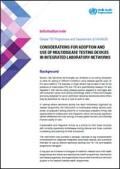
Resource | Publications,
In settings where laboratory testing has been traditionally organized by disease programme, the introduction of multidisease testing devices (also known as polyvalent testing platforms or multianalyte analysers) brings new opportunities for collaboration and integration, which can provide significant system efficiencies and cost savings, increase patient access, and ultimately improve quality of care.
Collaboration and integration should be a priority for both those countries with currently operational multidisease testing devices and those countries considering and planning for their introduction.
This information note provides a strategic overview of key implementation considerations for diagnostic integration using these devices, and is primarily intended for use by national laboratory services and TB, HIV, and hepatitis programme managers.
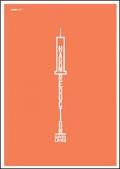
Resource | Publications,
People who use and inject drugs are among the groups at highest risk of exposure to HIV, but remain marginalized and out of reach of health and social services.
Evidence shows that harm reduction approaches such as needle-syringe programmes reduce the health, social and economic harms of drug use to individuals, communities and societies. They do not cause increases in drug use.
UNAIDS is calling for the global adoption of a peoplecentred, public health and human rights-based approach to drug use and for alternatives to the criminalization and incarceration of people who use drugs.
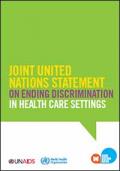
Resource | Publications,
Discrimination in health care settings is directed towards some of the most marginalized and stigmatized populations – the very populations that States promised to prioritize through the 2030 Agenda, and who are all too often excluded or left behind. Many individuals and groups face discrimination on the basis of their age, sex, race or ethnicity, health status, disability or vulnerability to ill health, sexual orientation or gender identity, nationality, asylum or migration status, or criminal record, often experiencing intersecting or compounding forms of discrimination.
Discrimination affects both users of health care services and health care workers. It serves as a barrier to accessing health services, affects the quality of health services provided, and reinforces exclusion from society for both individuals and groups.
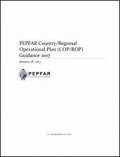
Resource | Publications,
PEPFAR’s focus on gaining sustainable control of the HIV epidemic made possible the announcement of bold PEPFAR HIV prevention and treatment targets for 2017 and 2018 at the 2016 Sustainable Development Goals Summit and the 2016 United Nations General Assembly. The focus on sustainable epidemic control began in 2014, when PEPFAR programs began pivoting to a data-driven approach that strategically targets geographic areas and populations where HIV/AIDS is most prevalent, and in which PEPFAR, in collaboration with host country governments, can achieve the greatest impact. With the focus of scaling HIV services in the highest disease burdened areas now being implemented, the streamlined Country Operational Plan (COP) for Fiscal Year (FY) 2017 focuses on impact and performance.
For the first time, we have evidence that PEPFAR program implementation can change the course of the epidemic evidenced by the impact assessments recently completed in Zambia, Zimbabwe, and Malawi. Controlling the HIV pandemic is possible.
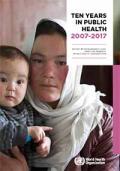
Resource | Publications,
Ten years in public health 2007-2017 chronicles the evolution of global public health over the decade that Dr. Margaret Chan has served as Director-General at the World Health Organization.
This series of chapters evaluates successes, setbacks, and enduring challenges during Dr. Chan's administration. They show what needs to be done when progress stalls or new threats emerge. The chapters show how WHO technical leadership can get multiple partners working together in tandem under coherent strategies. The importance of country leadership and community engagement is stressed repeatedly throughout the chapters.
These chapters tell a powerful story of global challenges and how they have been overcome. In a world facing considerable uncertainty, international health development is a unifying – and uplifting – force for the good of humanity.

Resource | Publications,
To celebrate 20 years since its inception, the World Drug Report 2017 is presented in a new five-booklet format designed to improve reader friendliness while maintaining the wealth of information contained within.
Booklet 1 summarizes the content of the four subsequent substantive booklets and presents policy implications drawn from their findings. Booklet 2 deals with the supply, use and health consequences of drugs. Booklet 3 focuses on the cultivation, production and consumption of the three plant-based drugs (cocaine, opiates and cannabis) and on the impact of new cannabis policies. Booklet 4 provides an extended analysis of the global synthetic drugs market and contains the bulk of the analysis for the triennial global synthetic drugs assessment. Finally, Booklet 5 contains a discussion on the nexus between the drug problem, organized crime, illicit financial flows, corruption and terrorism.
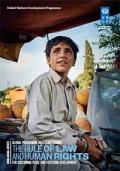
Resource | Publications,
Since 2008, the UNDP Global Programme on Strengthening the Rule of Law and Human Rights for Sustaining Peace and Fostering Development (previously known as Strengthening the Rule of Law in Crisis-Affected and Fragile Situations) has provided rule of law support to over 40 crisis-affected countries. The programme has been a driving force in improving the delivery of UNDP’s assistance and in pioneering joint UN approaches to supporting the rule of law. The 2012 establishment of the Global Focal Point for Police, Justice, and Corrections Areas in the Rule of Law in Post-Conflict and Other Crisis Situations is a notable development in this regard.
This Annual Report provides an overview of the first year of implementation of Phase III of the Global Programme (2016–2020) – highlighting the political and human rights dimensions of the rule of law and how our support contributes to sustaining peace. Part I, Year in Review, reflects on international policy developments affecting rule of law assistance and provides key country-level results achieved through the Global Programme in 2016. Part II, Country Profiles, presents an analysis of our engagement in 34 countries affected by crisis, conflict, and fragility. Lastly, Part III, provides detailed financial information on the Global Programme.
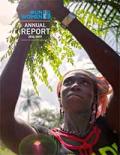
Resource | Publications,
This report showcases the many ways in which we support work at country and global level to turn the aims of the 2030 Agenda for Sustainable Development into results for women and girls worldwide, working closely with Member States and a wide range of partners to realize rights and build resilience.
Around the world, empowered women are achieving visible progress. We know the power of positive role modelling; how vital it is for girls growing up to see the success of their contemporaries, and through education, experience and example, for it to come within their grasp. In 2016, the first year of implementing the Sustainable Development Goals, we supported women to claim their right to equal treatment under the law, to gain elected office, to draw on the power of innovation and technology, and to become leaders through sports, among many other initiatives. We also supported civil society and women’s rights activists to inform and influence crucial policy discussions.

Resource | Publications,
Regionally in the Asia and Pacific, adolescents and young key populations are disproportionately affected by HIV/AIDS and yet are often excluded from policy, program and funding decisions at national, regional and global levels. This exclusion contributes to them being severely underserved by the HIV response. We believe the role of most affected communities in the HIV epidemic points to the crucial importance of their meaningful engagement in making policy and funding decisions. Young Key Populations are no exception.
This documentation was produced by Youth LEAD, The Regional Network of Young Key Population in Asia and Pacific as a showcase of our support and interventions to Young Key Populations from Indonesia, Pakistan and Vietnam who applied the Global Fund funding request as the first window applicants beginning from late 2016 to early 2017.





